By Leen Randell
Updated: Jul 04, 2024
10 Best Herbal Decoctions For Bleeding Gums
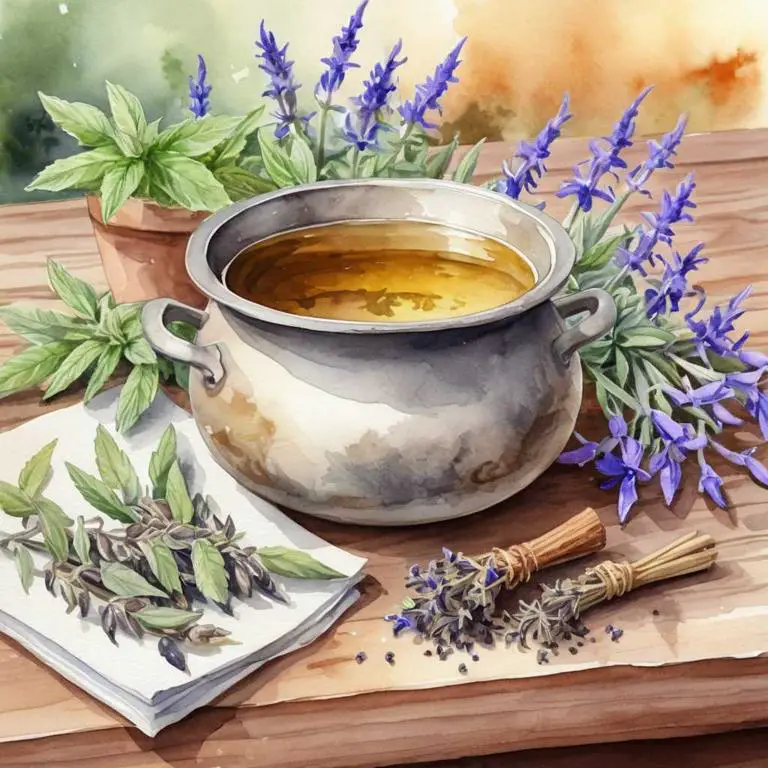
Herbal decoctions for bleeding gums are a natural remedy that has been used for centuries to alleviate the discomfort and embarrassment associated with gum disease.
These decoctions are made by steeping herbs in hot water, releasing their medicinal properties, which help to reduce inflammation, fight bacteria, and promote healing. Examples of herbal decoctions that have shown promise in treating bleeding gums include sage, chamomile, and clove, which can be used as mouthwashes or added to toothpaste.
By using these natural remedies, individuals can reduce the frequency and severity of bleeding gums, improving their oral health and overall quality of life.
The following article describes in detail the most important decoctions for bleeding gums, including medicinal properties, parts of herbs to use, and recipes for preparations.
- 1. Salvia officinalis
- 2. Calendula officinalis
- 3. Camellia sinensis
- 4. Melissa officinalis
- 5. Matricaria chamomilla
- 6. Echinacea angustifolia
- 7. Prunus avium
- 8. Berberis vulgaris
- 9. Hydrastis canadensis
- 10. Taraxacum officinale
- What is the best combination of herbal decoctions to use for bleeding gums?
- What ailments similar to bleeding gums are treated with herbal decoctions?
1. Salvia officinalis
Sage decoctions helps with bleeding gums because of its potent antimicrobial properties, which target the underlying causes of gum disease.
The flavonoids and phenolic acids in sage help to reduce inflammation and combat bacterial infections that can cause gum recession and bleeding. Additionally, sage's astringent properties can help to constrict blood vessels and stop bleeding, promoting healthy gums and reducing discomfort.
This natural remedy has been used for centuries to promote oral health and alleviate symptoms of periodontal disease.
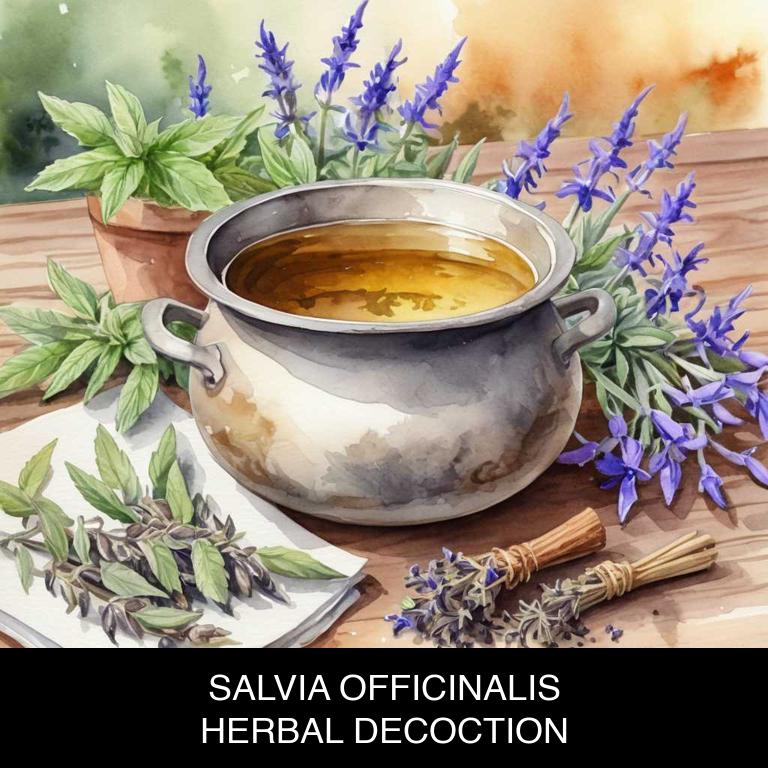
Medicinal Constituents
The list below shows the primary medicinal constituents in Salvia officinalis decoctions that help with bleeding gums.
- Ursolic acid: A triterpenoid acid that has anti-inflammatory properties, which can help reduce inflammation and swelling in the gums, thus alleviating bleeding.
- Rosmarinic acid: A phenolic compound with antioxidant and anti-inflammatory properties, which can help protect the gums from oxidative stress and inflammation, promoting healing and reducing bleeding.
- Carnosic acid: A phenolic diterpene with antioxidant and anti-inflammatory properties, which can help protect the gums from oxidative stress, reduce inflammation, and promote healing, ultimately reducing bleeding.
Parts Used
The list below shows the primary parts of sage used to make decoctions for bleeding gums.
- Leaves: They are used due to their high content of tannins and essential oils, which have anti-inflammatory and antimicrobial properties that help soothe and heal gums.
- Roots: The roots are used because they contain saponins and other compounds that have anti-inflammatory and antibacterial properties, which can help reduce gum inflammation and prevent infection.
- Stems: The stems are used for their astringent properties, which can help reduce bleeding and swelling in the gums by constricting blood vessels and reducing inflammation.
Quick Recipe
The following recipe gives a procedure to make a basic sage for bleeding gums.
- Measure out 2 grams of dried salvia officinalis leaves and place them in a heat-resistant glass container.
- Add 250 milliliters of distilled water to the container with the dried herb and let it steep for 5 minutes.
- Heat the mixture over low heat for 5-7 minutes or until the liquid has reduced to 125 milliliters.
- Strain the decoction through a cheesecloth or fine-mesh sieve into a clean glass container discarding the solids.
- Allow the decoction to cool to room temperature before transferring it to a glass bottle for storage.
2. Calendula officinalis
Pot marigold decoctions helps with bleeding gums because it possesses potent anti-inflammatory properties that reduce swelling and ease pain in the gum tissue.
The antioxidants present in the decoction also help to combat bacteria and other pathogens that contribute to gum disease, promoting a healthy environment for oral tissues.
Additionally, its antimicrobial activities help to control the growth of harmful microorganisms that can exacerbate bleeding gums, making it an effective natural remedy for maintaining a healthy and strong smile.

Medicinal Constituents
The list below shows the primary medicinal constituents in Calendula officinalis decoctions that help with bleeding gums.
- Flavonoids: These plant-based compounds help reduce inflammation and improve blood vessel function, which can aid in stopping bleeding gums by reducing swelling and promoting clotting.
- Calendulin: This triterpene saponin has antimicrobial and anti-inflammatory properties, which can help combat infections and reduce inflammation in the gums, ultimately promoting healing and stopping bleeding.
- Beta-sitosterol: This phytosterol has anti-inflammatory and antimicrobial properties, which can help reduce swelling and promote healing in the gums, thus stopping bleeding and promoting oral health.
Parts Used
The list below shows the primary parts of pot marigold used to make decoctions for bleeding gums.
- Flowers: They are used due to their anti-inflammatory and antimicrobial properties that help soothe and heal gums.
- Leaves: They are used due to their antiseptic and antibacterial properties that help prevent infection and promote healthy gum growth.
- Stems: They are used due to their anti-inflammatory properties that help reduce swelling and ease pain in bleeding gums.
Quick Recipe
The following recipe gives a procedure to make a basic pot marigold for bleeding gums.
- Gather calendula officinalis flowers and leaves in equal amounts of 1 to 2 tablespoons each.
- Combine the gathered calendula officinalis with 2 cups of boiling water in a heat-resistant glass container.
- Steep the mixture for 5 to 10 minutes to allow the active compounds to infuse into the water.
- Strain the decoction through a cheesecloth or a fine-mesh sieve into a clean glass container.
- Cool the decoction to room temperature before using it for topical applications or further processing.
3. Camellia sinensis
Tea decoctions helps with bleeding gums because they are rich in antioxidants, anti-inflammatory compounds, and antibacterial properties.
These properties help to reduce inflammation, fight off bacteria that can cause gum disease, and promote healthy blood flow to the gums. By drinking herbal tea decoctions regularly, individuals can help to soothe and heal their gums, reducing bleeding and discomfort.
Additionally, some herbs like sage and chamomile have natural antibacterial properties that can help to combat bacterial infections in the mouth, further aiding in the healing process.
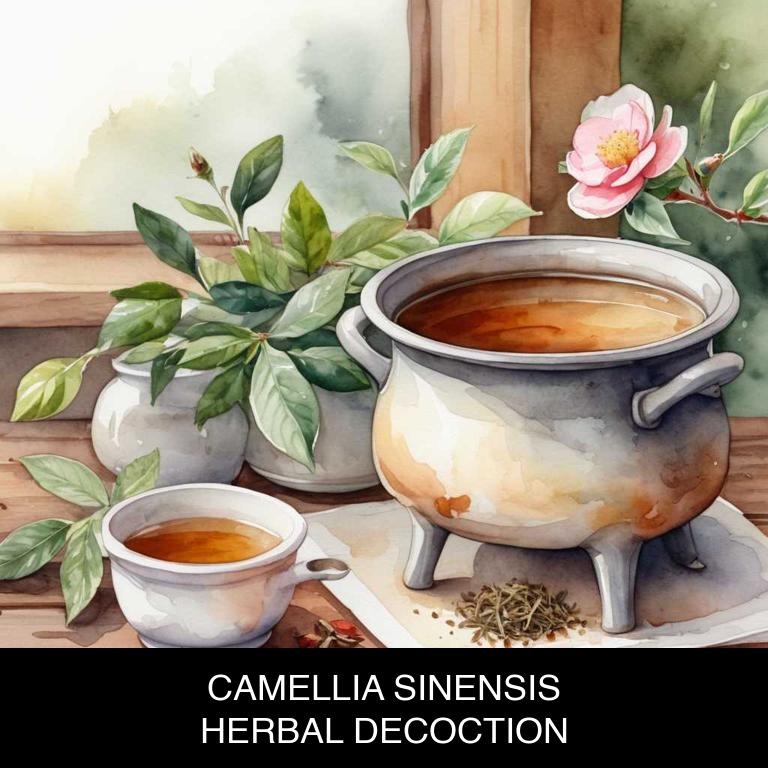
Medicinal Constituents
The list below shows the primary medicinal constituents in Camellia sinensis decoctions that help with bleeding gums.
- Catechins: Catechins, particularly epigallocatechin gallate (EGCG), help with bleeding gums by reducing inflammation and bacterial growth, thereby promoting healthy gum tissue.
- Theaflavins: Theaflavins, produced during tea fermentation, exhibit antibacterial properties that inhibit the growth of periodontal pathogens, contributing to the reduction of bleeding gums.
- Quinic acid-derived compounds: Quinic acid-derived compounds, such as quinic acid and quinic acid derivatives, display astringent properties that help reduce bleeding by constricting blood vessels and promoting coagulation.
Parts Used
The list below shows the primary parts of tea used to make decoctions for bleeding gums.
- Leaves: Camellia sinensis leaves are used to make decoctions for bleeding gums because they contain tannins and other compounds that help reduce inflammation and promote oral health.
- Roots: Camellia sinensis roots are used to make decoctions for bleeding gums because they have anti-inflammatory and astringent properties that help soothe and heal the gums.
- Buds: Camellia sinensis buds are used to make decoctions for bleeding gums because they are rich in antioxidants and flavonoids that help reduce inflammation and prevent further damage to the gums.
Quick Recipe
The following recipe gives a procedure to make a basic tea for bleeding gums.
- Harvest 30g of fresh camellia sinensis leaves or 15g of dried leaves for decoction.
- Rinse the leaves with cold water to remove dirt and impurities thoroughly.
- Chop the leaves into smaller pieces to increase surface area for infusion.
- Combine the chopped leaves with 1l of water in a saucepan and bring to a boil.
- Simmer the mixture for 5-10 minutes to release the active compounds from the leaves.
4. Melissa officinalis
Lemon balm decoctions helps with bleeding gums because of its natural antibacterial and anti-inflammatory properties.
The essential oils present in lemon balm, such as citral and geraniol, have been shown to effectively combat the bacteria that cause gum disease, reducing inflammation and promoting healthy gum tissue growth.
By soothing and calming the gums, lemon balm decoctions can help to reduce bleeding and alleviate discomfort associated with gum disease, ultimately leading to a healthier and more stable oral environment.
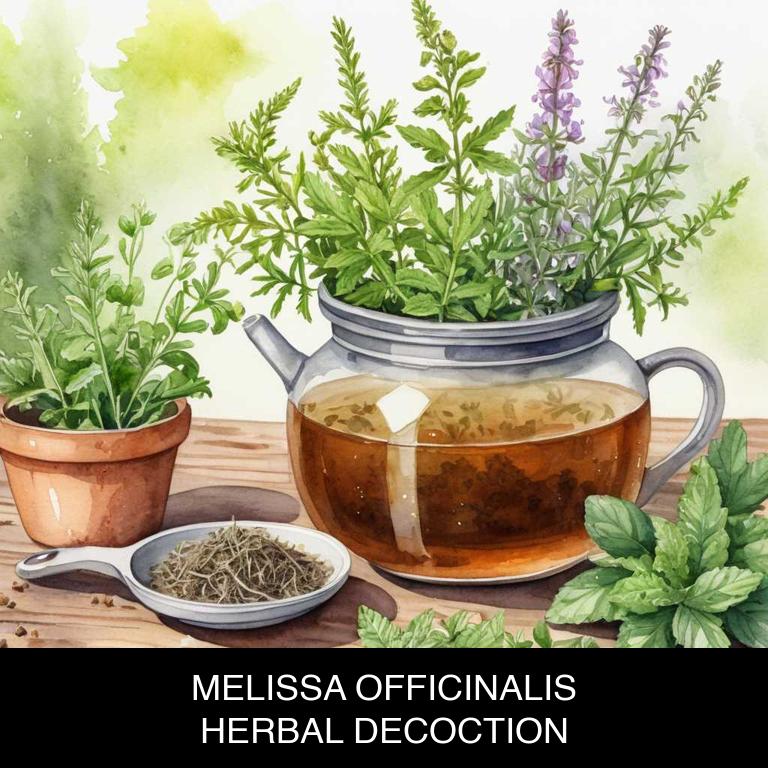
Medicinal Constituents
The list below shows the primary medicinal constituents in Melissa officinalis decoctions that help with bleeding gums.
- Rosmarinic acid: This phenolic compound has anti-inflammatory properties that help reduce swelling and inflammation in the gums, promoting healing and preventing bleeding.
- Luteolin: A flavonoid with potent antioxidant and anti-inflammatory effects, luteolin helps reduce gum inflammation and protects against oxidative stress, which can contribute to bleeding gums.
- Borneol: A terpene with antimicrobial and anti-inflammatory properties, borneol helps combat oral infections and reduces inflammation in the gums, thereby preventing bleeding and promoting gum health.
Parts Used
The list below shows the primary parts of lemon balm used to make decoctions for bleeding gums.
- Leaves: They are the most commonly used part due to their high concentration of bioactive compounds that help to reduce inflammation and fight bacteria.
- Stems: The stems of Melissa officinalis contain a high amount of flavonoids and tannins, which contribute to their anti-inflammatory and antibacterial properties.
- Flowers: The flowers of the plant are valued for their antiseptic and anti-inflammatory properties, which help to soothe and calm bleeding gums.
Quick Recipe
The following recipe gives a procedure to make a basic lemon balm for bleeding gums.
- Harvest 20-30 grams of fresh melissa officinalis leaves or 10 grams of dried leaves.
- Chop the leaves into small pieces to increase their surface area for infusion.
- Combine the chopped melissa leaves with 250 milliliters of boiling water in a heat-resistant container.
- Steep the mixture for 5-7 minutes to allow the active compounds to infuse into the water.
- Strain the decoction through a fine-mesh sieve or cheesecloth into a clean container.
5. Matricaria chamomilla
Chamomile decoctions helps with bleeding gums because of its anti-inflammatory and antimicrobial properties.
The soothing compounds in chamomile, such as apigenin and luteolin, reduce inflammation and swelling in the gum tissue, allowing it to heal faster. Additionally, chamomile's antibacterial properties help eliminate the bacteria that can cause gum disease and infections, promoting a healthy gum environment.
As a result, regular use of chamomile decoctions can help alleviate bleeding gums and prevent further damage.

Medicinal Constituents
The list below shows the primary medicinal constituents in Matricaria chamomilla decoctions that help with bleeding gums.
- Apigenin: This flavonoid acts as an anti-inflammatory agent, reducing inflammation and swelling in the gums, thereby alleviating bleeding gums.
- Luteolin: This flavonoid has antimicrobial properties, helping to combat the bacteria that cause gum infections and inflammation, which in turn reduces bleeding gums.
- Alpha-bisabolol: This sesquiterpene has anti-inflammatory and antiseptic properties, reducing inflammation and preventing infections in the gums, thus helping to alleviate bleeding gums.
Parts Used
The list below shows the primary parts of chamomile used to make decoctions for bleeding gums.
- Flowers: They are used due to their anti-inflammatory and antiseptic properties, which help soothe and calm bleeding gums.
- Leaves: Leaves are used due to their antibacterial properties, which help prevent infection and promote healing in bleeding gums.
- Stems: Stems are used due to their astringent properties, which help reduce bleeding and inflammation in gums.
Quick Recipe
The following recipe gives a procedure to make a basic chamomile for bleeding gums.
- Harvest fresh flowers of matricaria chamomilla in the early morning when they are at their peak potency.
- Dry the harvested flowers in a warm place or using a dehydrator at 30 degrees celsius for 1-2 hours.
- Measure out 2-3 teaspoons of dried flowers for every cup of water and combine them in a pot.
- Bring the mixture to a boil then reduce heat and let it simmer for 5-7 minutes to extract the active compounds.
- Strain the decoction through a cheesecloth or a fine-mesh sieve into a cup and discard the solids.
6. Echinacea angustifolia
Kansas coneflower decoctions helps with bleeding gums because of its natural anti-inflammatory properties.
The decoction's active compounds, such as isothiocyanates and phenolic acids, work to reduce swelling and alleviate gum inflammation, thus providing relief from discomfort and pain. Additionally, the antibacterial properties of Kansas coneflower help combat underlying infections that may be contributing to bleeding gums.
This natural remedy can effectively soothe and heal gum tissues, promoting healthy oral hygiene and overall dental health.

Medicinal Constituents
The list below shows the primary medicinal constituents in Echinacea angustifolia decoctions that help with bleeding gums.
- Iridoids: Iridoids, specifically echinacoside and isoechinacoside, have anti-inflammatory and antimicrobial properties that help reduce inflammation and prevent infection in bleeding gums.
- Alkylamides: Alkylamides, such as cis-12-isocaryophyllene, exhibit antimicrobial activity that helps combat oral infections that contribute to bleeding gums.
- Caffeic acid derivatives: Caffeic acid derivatives, including rosmarinic acid, possess antioxidant and anti-inflammatory properties that help protect the gums from oxidative stress and inflammation, reducing bleeding and promoting healing.
Parts Used
The list below shows the primary parts of kansas coneflower used to make decoctions for bleeding gums.
- Roots: They are used to make decoctions for bleeding gums due to their high concentration of compounds with anti-inflammatory and antimicrobial properties.
- Rhyzomes: They are used to make decoctions for bleeding gums because they contain bioactive compounds that help reduce inflammation and promote wound healing.
- Leaves: They are used to make decoctions for bleeding gums due to their ability to reduce inflammation and fight off infections with their bioactive compounds.
Quick Recipe
The following recipe gives a procedure to make a basic kansas coneflower for bleeding gums.
- Harvest fresh echinacea angustifolia roots from a trusted source in the early fall season.
- Clean and dry the roots for at least 2 hours or overnight to remove excess moisture.
- Chop the dried roots into small pieces using a sharp knife to increase surface area.
- Combine 1 teaspoon of the chopped roots with 1 cup of boiling water in a saucepan.
- Steep the mixture for 10-15 minutes and strain the liquid to remove the solids.
7. Prunus avium
Cherry decoctions helps with bleeding gums because it is rich in anthocyanins, powerful antioxidants that combat inflammation and oxidative stress.
These compounds help to reduce swelling and alleviate pain associated with gum disease. The decoction's antibacterial properties also inhibit the growth of bacteria that can cause infection and lead to bleeding. Additionally, cherry decoctions' astringent properties help to constrict blood vessels, reducing bleeding and promoting healing.
This natural remedy provides a gentle yet effective way to soothe and heal bleeding gums.
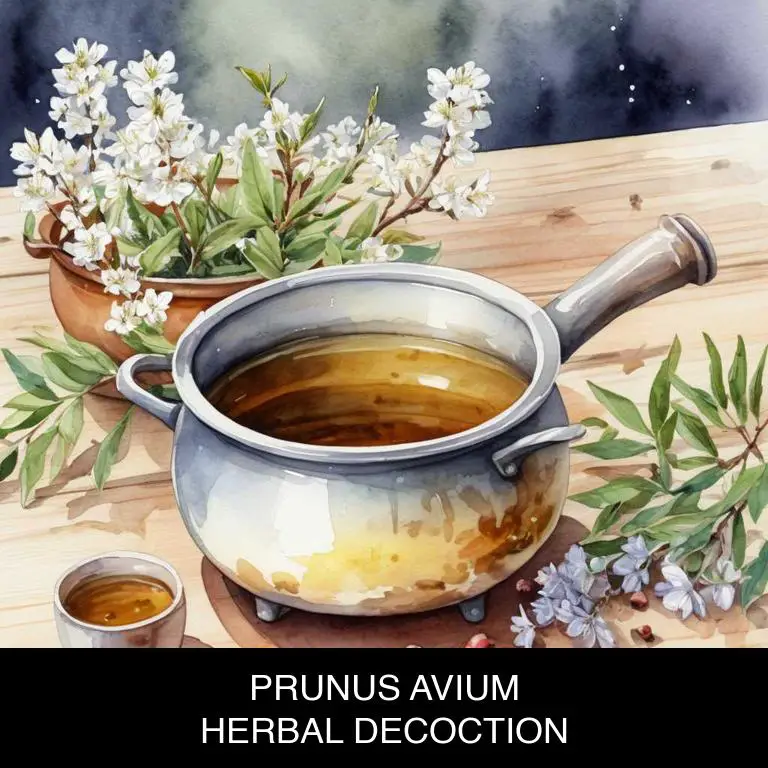
Medicinal Constituents
The list below shows the primary medicinal constituents in Prunus avium decoctions that help with bleeding gums.
- Flavonoids: These plant compounds help with bleeding gums by reducing inflammation and improving blood vessel integrity, thereby promoting healthy gum tissue and reducing bleeding.
- Phenolic acids: These compounds have antimicrobial properties and help reduce inflammation, which can contribute to bleeding gums by preventing the growth of bacteria that can irritate the gums.
- Tannins: These astringent compounds help with bleeding gums by constricting blood vessels, reducing bleeding, and promoting the healing of gum tissue.
Parts Used
The list below shows the primary parts of cherry used to make decoctions for bleeding gums.
- Barks: They contain tannins, which help in reducing inflammation and promoting healing of gums.
- Leaves: They are rich in flavonoids and phenolic acids, which have anti-inflammatory and antimicrobial properties to combat gum infections.
- Roots: They are a source of prunasin, a compound that has been traditionally used to treat gum inflammation and bleeding.
Quick Recipe
The following recipe gives a procedure to make a basic cherry for bleeding gums.
- Gather 1 pound of fresh or dried prunus avium leaves and flowers for this herbal decoction.
- Wash the gathered prunus avium material with cool water to remove any dirt or debris.
- Measure out 1 cup of the cleaned prunus avium material and place it in a saucepan.
- Steep the prunus avium material in 4 cups of boiling water for 10-15 minutes to release its properties.
- Strain the decoction through a cheesecloth or a fine-mesh sieve into a clean container.
8. Berberis vulgaris
Barberry decoctions helps with bleeding gums because of its natural anti-inflammatory properties, which reduce swelling and ease pain in the gum tissues.
The decoction's antimicrobial actions also combat bacteria that contribute to periodontal disease, a common cause of bleeding gums.
Additionally, barberry contains berberine, a compound that has been shown to inhibit the growth of oral bacteria, thereby promoting healthy gums and reducing inflammation, ultimately leading to a reduction in bleeding.
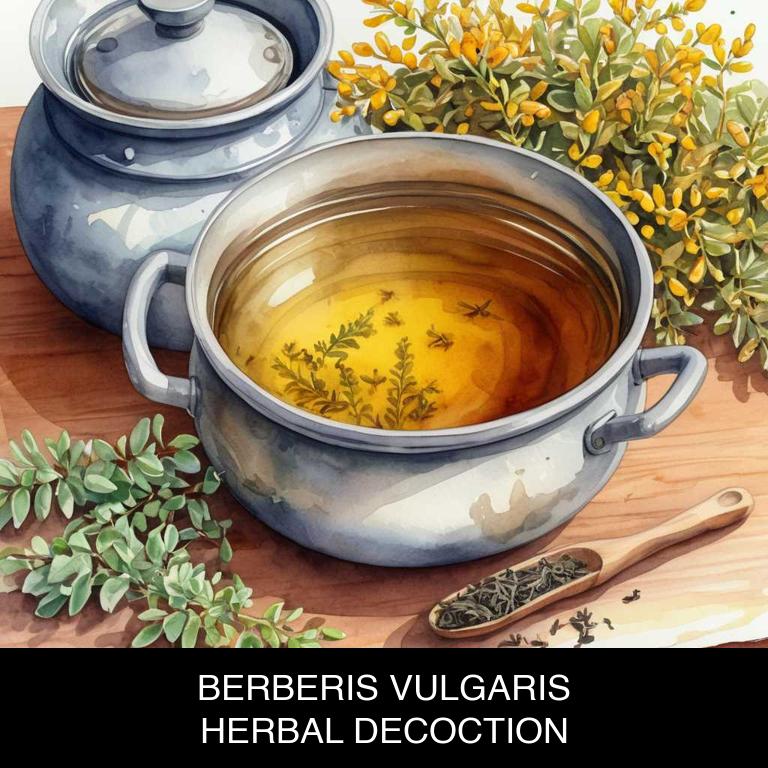
Medicinal Constituents
The list below shows the primary medicinal constituents in Berberis vulgaris decoctions that help with bleeding gums.
- Berberine: Berberine, an alkaloid, has anti-inflammatory and antimicrobial properties that help reduce inflammation and prevent infection in bleeding gums.
- Vescalagin: Vescalagin, a phenolic compound, exhibits antioxidant and anti-inflammatory activities that contribute to its ability to reduce gum inflammation and promote healing.
- Berbamine: Berbamine, an alkaloid, possesses antimicrobial properties that help combat bacterial infections in the gums, reducing inflammation and promoting wound healing.
Parts Used
The list below shows the primary parts of barberry used to make decoctions for bleeding gums.
- Roots: Roots: The root of Berberis vulgaris contains berberine, a compound that helps reduce inflammation and fight infection, making it effective in treating bleeding gums.
- Barks: Barks: The bark of Berberis vulgaris contains berberine and other compounds that have antimicrobial and anti-inflammatory properties, useful in soothing bleeding gums.
- Fruits: Fruits: The fruits of Berberis vulgaris, also known as barberries, contain anthocyanins, which have anti-inflammatory and antioxidant properties that help alleviate bleeding gums.
Quick Recipe
The following recipe gives a procedure to make a basic barberry for bleeding gums.
- Harvest 100 grams of fresh berberis vulgaris roots or 50 grams of dried roots for decoction.
- Clean the roots thoroughly with water to remove any dirt or debris.
- Chop the roots into small pieces to increase their surface area for infusion.
- Combine the chopped roots with 1 liter of water in a saucepan and bring to a boil.
- Simmer the decoction for 10 to 15 minutes to release the active compounds slowly.
9. Hydrastis canadensis
Goldenseal decoctions helps with bleeding gums because of its potent antibacterial and anti-inflammatory properties.
The herb contains berberine, a compound that has been shown to inhibit the growth of bacteria and fungi associated with gum disease. Additionally, goldenseal's anti-inflammatory properties help reduce swelling and redness in the gums, allowing for proper healing and reducing discomfort.
By addressing both the underlying infection and inflammation, goldenseal decoctions can provide effective relief from bleeding gums.
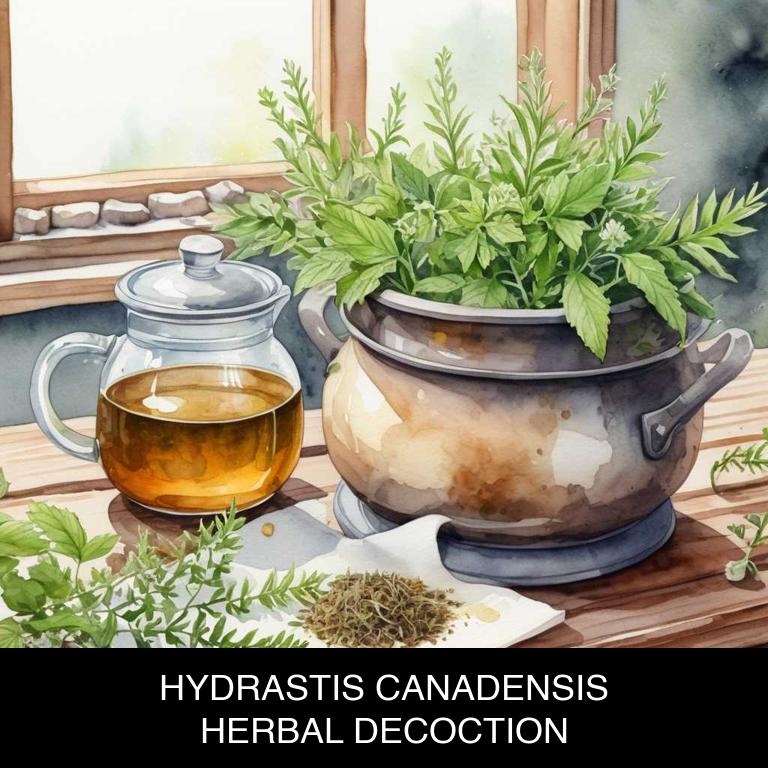
Medicinal Constituents
The list below shows the primary medicinal constituents in Hydrastis canadensis decoctions that help with bleeding gums.
- Berberine: This alkaloid has anti-inflammatory and antimicrobial properties, helping to reduce inflammation and prevent infection in bleeding gums, promoting healing and reducing symptoms.
- Hydrastine: This alkaloid exhibits antimicrobial and astringent properties, which help to reduce bleeding and inflammation by constricting blood vessels and preventing the growth of bacteria that can exacerbate gum disease.
- Vasaka glycosides: These phenolic compounds have anti-inflammatory and astringent properties, helping to reduce inflammation, prevent bleeding, and promote healing in bleeding gums by constricting blood vessels and reducing tissue damage.
Parts Used
The list below shows the primary parts of goldenseal used to make decoctions for bleeding gums.
- Roots: They contain the highest concentration of hydrastine, an alkaloid responsible for the medicinal properties of the plant.
- Stems: They contain a smaller amount of hydrastine, but are still used to make decoctions due to their ease of harvest and lower demand compared to roots.
- Leaves: Although less potent than roots, leaves are sometimes used in decoctions to take advantage of their available hydrastine content.
Quick Recipe
The following recipe gives a procedure to make a basic goldenseal for bleeding gums.
- Gather 20 grams of dried hydrastis canadensis root in a clean container for future use.
- Weigh 1/4 teaspoon of dried hydrastis canadensis root per cup of water in a pot.
- Boil 1 cup of water in a pot for 5-7 minutes to create a decoction base.
- Add 1/4 teaspoon of dried hydrastis canadensis root to the boiling water and steep for 10 minutes.
- Strain the liquid and discard the solids to obtain the hydrastis canadensis decoction.
10. Taraxacum officinale
Dandelion decoctions helps with bleeding gums because it possesses anti-inflammatory properties that reduce swelling and soothe the affected areas.
The decoction's high concentration of vitamins A, C, and K also promotes collagen production, which strengthens gum tissue and reduces bleeding. Additionally, dandelion's natural antibacterial agents help combat bacterial infections that can cause gum disease and inflammation, ultimately leading to improved oral health and reduced bleeding.
By incorporating dandelion decoctions into your oral care routine, you can promote healthy gums and a confident smile.

Medicinal Constituents
The list below shows the primary medicinal constituents in Taraxacum officinale decoctions that help with bleeding gums.
- Apigenin: This flavonoid has anti-inflammatory and antimicrobial properties, which help reduce inflammation and prevent infection in the gums, thereby promoting healing and stopping bleeding.
- Luteolin: This flavonoid has antioxidant and anti-inflammatory effects, which help protect the gums from oxidative stress and inflammation, thereby reducing bleeding and promoting tissue repair.
- Taraxasterol: This triterpene has anti-inflammatory and antimicrobial properties, which help reduce inflammation and prevent infection in the gums, thereby promoting healing and stopping bleeding.
Parts Used
The list below shows the primary parts of dandelion used to make decoctions for bleeding gums.
- Leaves: Leaves are used to make decoctions for bleeding gums due to their anti-inflammatory properties.
- Roots: Roots are used to make decoctions for bleeding gums due to their ability to reduce inflammation and combat infection.
- Stems: Stems are used to make decoctions for bleeding gums due to their astringent properties, which can help constrict blood vessels and reduce bleeding.
Quick Recipe
The following recipe gives a procedure to make a basic dandelion for bleeding gums.
- Gather 1 to 2 teaspoons of taraxacum officinale root and 1 to 2 teaspoons of taraxacum officinale leaves.
- Cut the taraxacum officinale root and leaves into small pieces to increase their surface area.
- Combine the cut taraxacum officinale root and leaves with 1 cup of boiling water in a heat-resistant cup.
- Steep the taraxacum officinale mixture for 5 to 10 minutes to allow the active compounds to infuse.
- Strain the taraxacum officinale decoction through a cheesecloth or a fine-mesh sieve into a clean cup.
What is the best combination of herbal decoctions to use for bleeding gums?
The best combination of herbal decoctions that help with bleeding gums is a blend of calendula, peppermint, and aloe vera.
Calendula's anti-inflammatory properties reduce swelling and promote healing, while peppermint's antibacterial properties combat oral infections. Aloe vera's soothing properties calm the gums and aid in tissue repair. Combine equal parts of each decoction, steep for 5-7 minutes, and strain before using as a mouthwash or applying directly to the affected area.
Regular use can help alleviate bleeding gums and promote overall oral health.
What ailments similar to bleeding gums are treated with herbal decoctions?
Ailments similar to bleeding gums that are treated with herbal decoctions are various oral and mucous membrane conditions.
Herbal decoctions are used to treat conditions like mouth sores, tongue ulcers, and thrush, which exhibit symptoms such as inflammation, swelling, and irritation.
Decoctions made from herbs like Calendula, Chamomile, and Myrrh have anti-inflammatory and antibacterial properties that help soothe and heal these oral lesions.